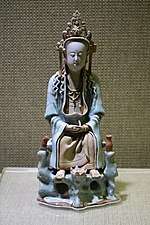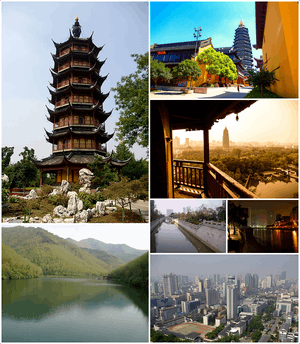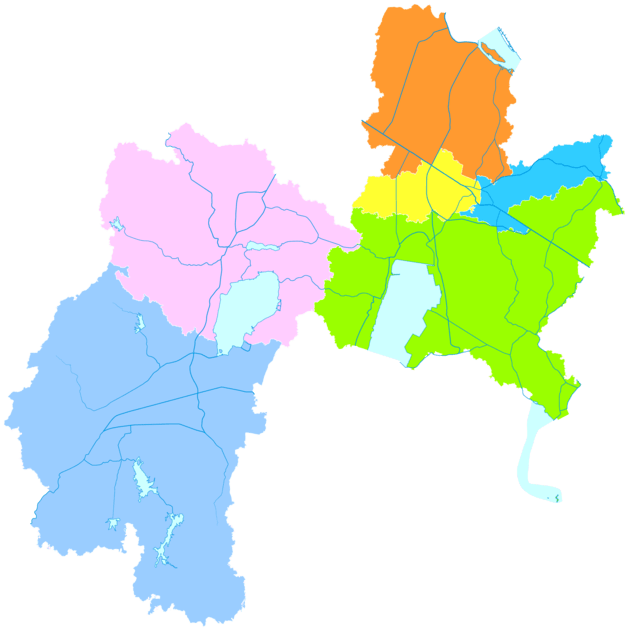Changzhou
Changzhou is a prefecture-level city in southern Jiangsu province of China. It was previously known as Yanling, Lanling and Jinling. Located on the southern bank of the Yangtze River, Changzhou borders the provincial capital of Nanjing to the west, Zhenjiang to the northwest, Wuxi to the east, and the province of Zhejiang to the south. Changzhou is located in the highly developed Yangtze Delta region of China extending from Shanghai going northwest. The population of Changzhou city was 4,592,431 at the 2010 census, and its metropolitan area population was 12.4 million.[2][3]
History

"The Ruins of Yancheng" (淹城遺址), comprise the remains of a walled city located in the Wujin district of Changzhou that was founded over 3000 years ago at the beginning of the Western Zhou dynasty. The earliest record of a settlement on the site of modern Changzhou is as a commandery founded in 221 BC at the beginning of the Qin Dynasty. During the interregnum between the Sui and Tang, the city of Piling (毗陵) was the capital of Shen Faxing's short-lived Kingdom of Liang (AD 619 to 620). Changzhou got its present name meaning "ordinary prefecture" in 589. Following construction of the Grand Canal in 609, Changzhou became a canal port and transshipment point for locally-grown grain, and has maintained these roles ever since. The rural counties surrounding Changzhou are noted for the production of rice, fish, tea, silk, bamboo and fruit.

During the Taiping Rebellion of the 1850s, one of five palaces housing the leaders of the so-called "Kingdom of Celestial Peace" was constructed in Changzhou. Today the ruins of the "King's Palace" can be found near the People's No.1 Hospital.
In the 1920s, Changzhou started to attract cotton mills. The cotton industry got a boost in the late 1930s when businesses began relocating outside of Shanghai due to the Japanese occupation. Unlike many Chinese cities, Changzhou continued to prosper even during the upheavals of the Cultural Revolution of 1966–76. Today it is an important industrial center for textiles, food processing, engineering (diesel engines, generators, transformers and other machinery), and high technology.
Administration
The prefecture-level city of Changzhou administers seven county-level divisions, including five districts and one county-level city.
| Map | |||||
|---|---|---|---|---|---|
| Subdivision | Simplified Chinese | Hanyu Pinyin | Population (2010) | Area (km2) | Density (/km2) |
| City Proper | |||||
| Tianning District | 天宁区 | Tiānníng Qū | 513,682 | 154.84 | 3,317.50 |
| Zhonglou District | 钟楼区 | Zhōnglóu Qū | 505,936 | 132.93 | 3,806.03 |
| Suburban | |||||
| Xinbei District | 新北区 | Xīnběi Qū | 596,807 | 508.91 | 1,172.72 |
| Wujin District | 武进区 | Wǔjìn Qū | 1,674,123 | 1,065.26 | 1,571.56 |
| Jintan District | 金坛区 | Jīntán Qū | 552,047 | 975.68 | 565.81 |
| Satellite cities (County-level cities) | |||||
| Liyang City | 溧阳市 | Lìyáng Shì | 749,377 | 1,534.52 | 488.35 |
| Total | 4,591,972 | 4,372.15 | 1,050.28 | ||
| Dissolved district: Qishuyan District | |||||
Demographics
Its total population was 4,592,431 inhabitants at the 2010 census, an average 2% per year increase since the previous census, and 3,290,918 lived in the built-up area made up of 5 urban districts.[3] The encompassing metropolitan area was estimated by the OECD (Organisation for Economic Co-operation and Development) to have, as of 2010, a population of 12.4 million.[2] The agglomeration is now part of the greater Suzhou-Wuxi-Changzhou metropolitan region, which has now more than 36,000,000 inhabitants.
Education
Changzhou is an educational hub and is home to several universities, including Changzhou University, Hohai University (Changzhou campus), Jiangsu Teachers' University of Science and Technology, Jiangsu Teachers' University of Technology, and Changzhou Institute of Technology. The city also has a number of prominent secondary schools, including the Changzhou Senior High School of Jiangsu Province.
Economy
Changzhou's traditional role has been that of a commercial center and in particular a distribution center for agricultural produce, which was shipped by canal to the north and later, to Shanghai. The city began to develop a cotton textile industry in the 1920s, and cotton mills were established in the late 1930s, when Japanese attacks drove many Chinese businesses to invest outside Shanghai.
The city has remained a textile center and the most important location in Jiangsu Province for weaving. It also has large food-processing plants as well as flour-milling, rice-polishing, and oil-pressing industries. After 1949 it also developed as a centre of the engineering industry. Qishuyan, some 10 km (6.2 mi) southeast of Changzhou, has one of the largest locomotive and rolling stock plants in China. Other engineering works in Changzhou produce diesel engines, generators, transformers along with agricultural and textile machinery. At the time of the Great Leap Forward in 1958 a steel plant was also built to provide raw material for heavy industry.
Since 1908, Changzhou has been linked by rail with Shanghai and Nanjing (see below for transportation).
Up until now, Changzhou has remained one of the most developed cities in Jiangsu, ranked third after Suzhou and Wuxi. The city's 2009 GDP per capita of ¥70,103 in 2009, less than that of Suzhou and Wuxi but more than the capital city Nanjing, ranked the city third in Jiangsu, .
Changzhou is also one of the top business cities in China. According to Forbes ranking, Changzhou was the 9th best business city in mainland China in 2008.
Industrial Zones
- Changzhou Export Processing Zone
Approval for the establishment of Changzhou Export Processing Zone was given in June 2005 with a planned area of 1.66 km2 (0.64 sq mi). Near to Shanghai and Nanjing via convenient transportation links, the zone began operation in October 2006. Investors enjoy a series of preferential policies whilst all handle export procedures are handled inside the export processing zone. The zone focuses on electronic information, electromechanical integration and new materials.[4]
- Changzhou National Hi-Tech District
Changzhou National Hi-Tech District (CND) is a state-level high-tech industrial development zone. It is located in the northern part of Changzhou city. With a population of 500,000 and an area of 439 square km, the district is 160 km (99 mi) from Shanghai to the east and 110 km (68 mi) from Nanjing to the west. The district represents the highest-level and most sophisticated industrial park in Changzhou. More than 1,300 foreign companies and over 5,000 local industrial enterprises have been registered within the district of which around 40% are from European and American countries. Industries encouraged include engineering machinery, transformer & transmission equipment, automotive, locomotive & locomotive components, parts, precision machinery, biotechnology, pharmaceuticals, photo-voltaic (PV) and new materials, chemicals, garment and textiles production, computer software and research & development. Some major investors include Terex, Komatsu, Ashland Chemical, Johnson, Caltex Oil Corp., Disa, +GF+, Rieter and General Electronics.[5]
Climate
The climate is Humid Subtropical Cwa, with cold but not severe winter and very warm and humid summers. Changzhou has a wide range of temperature differences throughout the year.
| Climate data for Changzhou (1971–2000) | |||||||||||||
|---|---|---|---|---|---|---|---|---|---|---|---|---|---|
| Month | Jan | Feb | Mar | Apr | May | Jun | Jul | Aug | Sep | Oct | Nov | Dec | Year |
| Average high °C (°F) | 7.1 (44.8) |
8.6 (47.5) |
12.9 (55.2) |
19.6 (67.3) |
25.1 (77.2) |
28.3 (82.9) |
31.8 (89.2) |
31.6 (88.9) |
27.1 (80.8) |
22.2 (72) |
16.0 (60.8) |
10.0 (50) |
20.0 (68) |
| Average low °C (°F) | 0.0 (32) |
1.4 (34.5) |
5.2 (41.4) |
10.9 (51.6) |
16.3 (61.3) |
20.9 (69.6) |
25.0 (77) |
24.7 (76.5) |
20.1 (68.2) |
14.3 (57.7) |
7.9 (46.2) |
2.0 (35.6) |
12.4 (54.3) |
| Average precipitation mm (inches) | 44.6 (1.756) |
53.7 (2.114) |
89.2 (3.512) |
81.2 (3.197) |
102.4 (4.031) |
189.3 (7.453) |
171.7 (6.76) |
116.1 (4.571) |
92.2 (3.63) |
68.7 (2.705) |
52.7 (2.075) |
29.6 (1.165) |
1,091.4 (42.969) |
| Average precipitation days (≥ 0.1 mm) | 8.7 | 9.8 | 13.0 | 11.4 | 11.7 | 12.8 | 12.8 | 11.3 | 9.5 | 8.7 | 7.0 | 6.1 | 122.8 |
| Source: [6] | |||||||||||||
Transportation
Railway
Located just south of the Chang Jiang (Yangtze River), Changzhou station is situated on the original Beijing–Shanghai railway. Changzhou North station was completed in 2011 and is located in the north of Changzhou in the Xinbei district on the Beijing–Shanghai high-speed railway. Changzhou is also one of the main stops on the busy Shanghai–Nanjing intercity railway, with two stations located in Changzhou (Changzhou station and Qishuyuan station).
Air travel
Changzhou Benniu Airport is approximately 15 km (9.3 mi) from the city center. There are domestic flights to Beijing, Guangzhou, Chengdu, Shenyang, Kunming, Harbin and Dalian, and international flights to Taiwan, South Korea, Thailand, Vietnam, Indonesia and Japan.
Roads
- China National Highway 312
- Shanghai-Nanjing Highway
- Yanjiang Highway
- Changzhou-Nanjing Highway
Bus Rapid Transport System
Use of the Bus Rapid Transit System costs one yuan (or, if a Changzhou Bus Card is used, either three or six jiao depending on the type of card) and provides access throughout Changzhou. The BRT has the following specifications: separate bus lanes or bus-only roadways, a vast network of routes and corridors, high capacity buses operating both outside and inside these corridors, greater passenger volume as compared to that in mixed traffic lanes (-3000 pphpd), enhanced station environments (not just simple bus shelters), automated pre-boarding fare collection and fare verification, street level boarding and alighting, low emission vehicle technology (Euro III or higher), weather protection on station platforms, centralized system controls, real-time next bus information display, a distinctive marketing identity, high-quality passenger service at bus stations, segregated bike lanes along main corridor(s) as well as station access for disabled persons. The BRT is also located in the following cities: Beijing, Chongqing, Dalian, Guangzhou, Jinan, Hangzhou, Hefei, Kunming, Xiamen, Zhengzhou[7] and Wulumuqi. A metro network is nevertheless in planning stage.
Elevated road
Changzhou built its first elevated road, the "Outer Ring Elevated Road",consisting of "Longcheng Blvd. Elevated Road" and "Longjiang Rd. Elevated Road", in 2007 and it came into use in 2008. Now the elevated road has formed a ring surrounding the urban area of Changzhou, linking main Highways.
Underground
Changzhou Metro is being constructed. The inauguration is scheduled for 2019.
Culture and folklore

The Changzhou dialect is a member of the Wu Chinese language family.
Comb Lane in Changzhou is the scene of the last farewell of Jia Baoyu with his father in the classic novel A Dream of Red Mansions.
Other famous handicrafts of Changzhou are silk embroidery in a "crisscross" style and carvings made from green bamboo.
Noted snacks made in Changzhou include pickled radish, sesame candy, sweet glutinous rice flour dumpling with fermented glutinous rice, and silver thread noodles (also known as dragon's beard noodles).
Tourism

Changzhou is the home of the China Dinosaur Park (simplified Chinese: 常州恐龙园; traditional Chinese: 常州恐龍園; pinyin: Chángzhōu Kǒnglóng Yuán) located in the Xinbei District of the city. The 5A rated Dinosaur Park has a collection of dinosaur bones and fossils from all over China. The park has 50 various fossils and more than 30 amusement programs including the Brontosaurus Roller Coaster and the Whirling Dinosaur Carriage. The fossils are located in a museum housed in a single building and the amusement rides are spread throughout the park which is categorized into six themed areas. Besides fossils and family oriented rides, Dinosaur Park is home to a giant panda and sea lions.[8]
In 2011, a new amusement park called CC Joyland (simplified Chinese: 环球动漫嬉戏谷; traditional Chinese: 環球動漫嬉戲谷; pinyin: Huánqiú dòngmàn xīxì gǔ) opened in Taihuwan near Taihu lake in Wujin District in the south of Changzhou.
The city is also home to the Tianning Temple—one of the largest Zen Buddhist temple and monasteries in China. The city recently rebuilt the Tianning pagoda in the temple grounds, which is adjacent to Hongmei Park. The pagoda, called the Tianning Baota, was first built during the Tang Dynasty (AD 618 - 907). Since that time it has been destroyed and rebuilt five times. The current reconstruction is built to the height specification of 153.79 m (504.6 ft). This makes it the tallest pagoda in China and perhaps also the world. Both the Hongmei Park and Tianning Temple are located just to the east of the city centre.[9]
As Changzhou is noted for its combs, the city has reconstructed its Fine Comb Lane area with contemporary architecture. Changzhou combs can be purchased in most places in the city.
There is the Hong Mei Park, which includes a small children's amusement park, a zoo, a rose garden and many scenic waterways. Of historical interest in the park is a historical pavilion with exhibits related to the Changzhou comb industry. In addition, there is another pavilion which displays locally produced root carvings. The park attracts large numbers of people during holidays and is often dotted with a variety of vendors.
Other sites include Changzhou's sunken city and area of archaeological ruins from the Spring and Autumn period.
Dongpo Park is located in the east part of downtown of Changzhou city, and its original name is Dongjiao Park. It covers 2.667 hectares, and is a typical Jiangnan Garden composed of cultural sites and natural landscape. During the time of south Song dynasty, the civilians of Changzhou established Yizhou Pavilion to commemorate, Su Dongpo, who was the great literature master and used to come to Changzhou. During the time of Qing dynasty, Kangxi and Qianlong, two emperors southwardly visited, they ordered to build up the temporary palace here and reconstructed this pavilion.
Changzhou also has attractive gardens such as the Wei Yuan.
The Old Museum of Wisteria is also located in the city.
Notable people
A Qing dynasty poet declared "there are none such under heaven as Changzhou, where famous persons come from".
- Su Dongpo (Su Shi; 1036–1101), poet and essayist.
- Sheng Xuanhuai (1844–1916), late Qing Dynasty bureaucrat and reformer.
- Lu Simian (1884–1957), historian and member of the Doubting Antiquity School
- Zhao Yuanren (1892–1982), prominent linguist.
- Hong Shen (1894–1955), pioneering dramatist and filmmaker was born here.
- Yun Daiying (1895–1931), revolutionary and pioneer of early Communist Youth activities.
- Liu Haisu (1896–1994), prominent artist.
- Zhang Tailei (1898–1927), one of the founders of Chinese Communist Party, first Chinese ever working in Communist International.
- Qu Qiubai (1899–1935), former General Secretary of the Communist Party of China and prominent Marxist thinker and writer. Named "Changzhou San Jie" together with Yun Daiying and Zhang Tailei.
- Zhou Youguang (1906–2017), linguist often credited as the "father of Hanyu Pinyin"
- Hua Luogeng (1910–1985), prominent mathematician.
- Xie Zhiliu (1910–1997), prominent painter.
- Tang Jun (1965–), former President of Microsoft in China.
- Lu Lan (1987–), Olympic athlete and badminton player. Won the woman's championship at the 2009 BWF World Championships.
See also
References
- 1 2 "Changzhou ( Jiangsu ) City Information" (in Chinese). Changzhou Municipal Statistic Bureau. 2010-03-01. Retrieved 2010-06-30.
- 1 2 3 OECD Urban Policy Reviews: China 2015, OECD READ edition. OECD iLibrary. OECD. 18 April 2015. p. 37. doi:10.1787/9789264230040-en. ISBN 9789264230033. ISSN 2306-9341. Linked from the OECD here
- 1 2 "China: Jiāngsū (Prefectures, Cities, Districts and Counties) - Population Statistics, Charts and Map". www.citypopulation.de.
- ↑ RightSite.asia | Changzhou Export Processing Zone
- ↑ RightSite.asia | Changzhou National Hi-Tech District
- ↑ "常州 - 气象数据 - 中国天气网". www.weather.com.cn.
- ↑ http://www.chinabrt.org/en/cities/changzhou.aspx
- ↑ "中华恐龙园官网". www.cnkly.com.
- ↑ "Buddhists gather to inaugurate world's tallest pagoda". China Daily. Xinhua. 2007-04-30. Retrieved 2007-04-30.
External links
| Wikimedia Commons has media related to Changzhou. |
| Wikivoyage has a travel guide for Changzhou. |
- Government website of Changzhou (in Chinese)
- Changzhou city guide with open directory (Jiangsu.NET)
- The history and culture of Changzhou city (Mildchina.com)
- Café Zeeland - The first European style café of Changzhou (in Chinese)
- Universities available for international students in Changzhou




